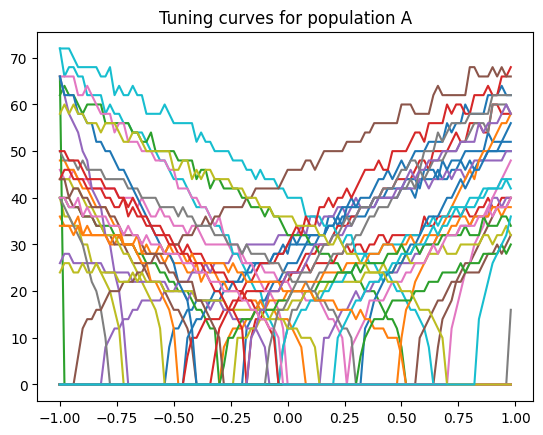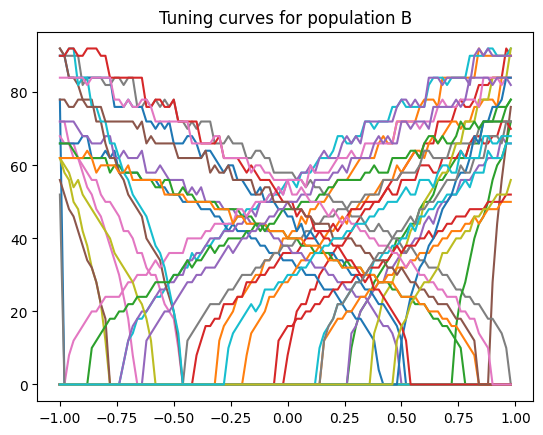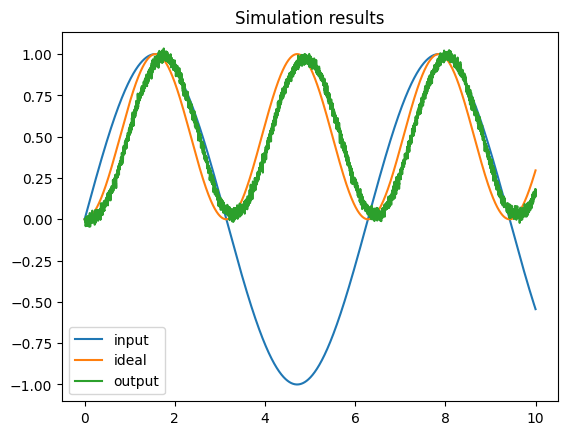Note
This documentation is for a development version. Click here for the latest stable release (v4.0.0).
The NEF algorithm¶
While Nengo provides a flexible, general-purpose approach to neural modelling, some aspects rely on the Neural Engineering Framework (NEF) to help specify network behavior. The theory behind the Neural Engineering Framework is developed at length in Eliasmith & Anderson, 2003: “Neural Engineering” and a short summary is available in Stewart, 2012: “A Technical Overview of the Neural Engineering Framework”.
However, for some people, the best description of an algorithm is the code itself. With that in mind, the following is a complete implementation of the NEF for the special case of two one-dimensional populations with a single connection between them. You can adjust the function being computed, the input to the system, and various neural parameters.
This example does not use Nengo at all. It is Python code that only requires Numpy (for the matrix inversion) and Matplotlib (to produce graphs of the output).
Introduction¶
The NEF is a method for building large-scale neural models using realistic neurons. It is a neural compiler: you specify the high-level computations the model needs to compute, and the properties of the neurons themselves, and the NEF determines the neural connections needed to perform those operations.
This script shows how to build a simple feed-forward network of leaky integrate-and-fire neurons where each population encodes a one-dimensional value and the connection weights between the populations are optimized to compute some arbitrary function. This same approach is used in Nengo, extended to multi-dimensional representation, multiple populations of neurons, and recurrent connections.
To change the input to the system, change input. To change the function computed by the weights, change function.
The size of the populations and their neural properties can also be adjusted by changing the parameters below.
[1]:
%matplotlib inline
import math
import random
import numpy
import matplotlib.pyplot as plt
dt = 0.001 # simulation time step
t_rc = 0.02 # membrane RC time constant
t_ref = 0.002 # refractory period
t_pstc = 0.1 # post-synaptic time constant
N_A = 50 # number of neurons in first population
N_B = 40 # number of neurons in second population
N_samples = 100 # number of sample points to use when finding decoders
rate_A = 25, 75 # range of maximum firing rates for population A
rate_B = 50, 100 # range of maximum firing rates for population B
def input(t):
"""The input to the system over time"""
return math.sin(t)
def function(x):
"""The function to compute between A and B."""
return x * x
Step 1: Initialization¶
[2]:
# create random encoders for the two populations
encoder_A = [random.choice([-1, 1]) for _ in range(N_A)]
encoder_B = [random.choice([-1, 1]) for _ in range(N_B)]
def generate_gain_and_bias(count, intercept_low, intercept_high, rate_low, rate_high):
gain = []
bias = []
for _ in range(count):
# desired intercept (x value for which the neuron starts firing
intercept = random.uniform(intercept_low, intercept_high)
# desired maximum rate (firing rate when x is maximum)
rate = random.uniform(rate_low, rate_high)
# this algorithm is specific to LIF neurons, but should
# generate gain and bias values to produce the desired
# intercept and rate
z = 1.0 / (1 - math.exp((t_ref - (1.0 / rate)) / t_rc))
g = (1 - z) / (intercept - 1.0)
b = 1 - g * intercept
gain.append(g)
bias.append(b)
return gain, bias
# random gain and bias for the two populations
gain_A, bias_A = generate_gain_and_bias(N_A, -1, 1, rate_A[0], rate_A[1])
gain_B, bias_B = generate_gain_and_bias(N_B, -1, 1, rate_B[0], rate_B[1])
def run_neurons(input, v, ref):
"""Run the neuron model.
A simple leaky integrate-and-fire model, scaled so that v=0 is resting
voltage and v=1 is the firing threshold.
"""
spikes = []
for i, vi in enumerate(v):
dV = dt * (input[i] - vi) / t_rc # the LIF voltage change equation
v[i] += dV
if v[i] < 0:
v[i] = 0 # don't allow voltage to go below 0
if ref[i] > 0: # if we are in our refractory period
v[i] = 0 # keep voltage at zero and
ref[i] -= dt # decrease the refractory period
if v[i] > 1: # if we have hit threshold
spikes.append(True) # spike
v[i] = 0 # reset the voltage
ref[i] = t_ref # and set the refractory period
else:
spikes.append(False)
return spikes
def compute_response(x, encoder, gain, bias, time_limit=0.5):
"""Measure the spike rate of a population for a given value x."""
N = len(encoder) # number of neurons
v = [0] * N # voltage
ref = [0] * N # refractory period
# compute input corresponding to x
input = []
for i in range(N):
input.append(x * encoder[i] * gain[i] + bias[i])
v[i] = random.uniform(0, 1) # randomize the initial voltage level
count = [0] * N # spike count for each neuron
# feed the input into the population for a given amount of time
t = 0
while t < time_limit:
spikes = run_neurons(input, v, ref)
for i, s in enumerate(spikes):
if s:
count[i] += 1
t += dt
return [c / time_limit for c in count] # return the spike rate (in Hz)
def compute_tuning_curves(encoder, gain, bias):
"""Compute the tuning curves for a population"""
# generate a set of x values to sample at
x_values = [i * 2.0 / N_samples - 1.0 for i in range(N_samples)]
# build up a matrix of neural responses to each input (i.e. tuning curves)
A = []
for x in x_values:
response = compute_response(x, encoder, gain, bias)
A.append(response)
return x_values, A
def compute_decoder(encoder, gain, bias, function=lambda x: x):
# get the tuning curves
x_values, A = compute_tuning_curves(encoder, gain, bias)
# get the desired decoded value for each sample point
value = numpy.array([[function(x)] for x in x_values])
# find the optimal linear decoder
A = numpy.array(A).T
Gamma = numpy.dot(A, A.T)
Upsilon = numpy.dot(A, value)
Ginv = numpy.linalg.pinv(Gamma)
decoder = numpy.dot(Ginv, Upsilon) / dt
return decoder
# find the decoders for A and B
decoder_A = compute_decoder(encoder_A, gain_A, bias_A, function=function)
decoder_B = compute_decoder(encoder_B, gain_B, bias_B)
# compute the weight matrix
weights = numpy.dot(decoder_A, [encoder_B])
Step 2: Running the simulation¶
[3]:
v_A = [0.0] * N_A # voltage for population A
ref_A = [0.0] * N_A # refractory period for population A
input_A = [0.0] * N_A # input for population A
v_B = [0.0] * N_B # voltage for population B
ref_B = [0.0] * N_B # refractory period for population B
input_B = [0.0] * N_B # input for population B
# scaling factor for the post-synaptic filter
pstc_scale = 1.0 - math.exp(-dt / t_pstc)
# for storing simulation data to plot afterward
inputs = []
times = []
outputs = []
ideal = []
output = 0.0 # the decoded output value from population B
t = 0
while t < 10.0: # noqa: C901 (tell static checker to ignore complexity)
# call the input function to determine the input value
x = input(t)
# convert the input value into an input for each neuron
for i in range(N_A):
input_A[i] = x * encoder_A[i] * gain_A[i] + bias_A[i]
# run population A and determine which neurons spike
spikes_A = run_neurons(input_A, v_A, ref_A)
# decay all of the inputs (implementing the post-synaptic filter)
for j in range(N_B):
input_B[j] *= 1.0 - pstc_scale
# for each neuron that spikes, increase the input current
# of all the neurons it is connected to by the synaptic
# connection weight
for i, s in enumerate(spikes_A):
if s:
for j in range(N_B):
input_B[j] += weights[i][j] * pstc_scale
# compute the total input into each neuron in population B
# (taking into account gain and bias)
total_B = [0] * N_B
for j in range(N_B):
total_B[j] = gain_B[j] * input_B[j] + bias_B[j]
# run population B and determine which neurons spike
spikes_B = run_neurons(total_B, v_B, ref_B)
# for each neuron in B that spikes, update our decoded value
# (also applying the same post-synaptic filter)
output *= 1.0 - pstc_scale
for j, s in enumerate(spikes_B):
if s:
output += decoder_B[j][0] * pstc_scale
if t % 0.5 <= dt:
print(t, output)
times.append(t)
inputs.append(x)
outputs.append(output)
ideal.append(function(x))
t += dt
0 0.0
0.001 0.0
0.5000000000000003 0.13129301856271738
1.0000000000000007 0.5450690659758561
1.5009999999999455 0.95231534868368
2.0009999999998906 0.9382343552958707
2.5009999999998356 0.527844797532709
3.0009999999997805 0.10631833069551058
3.5009999999997254 0.06504919626509627
4.000999999999671 0.40778860739000333
4.500999999999838 0.8297281240591255
5.000000000000004 0.9469244128041495
5.500000000000171 0.7009979435960725
6.000000000000338 0.22399668156578897
6.500000000000505 0.06605241419392653
7.000000000000672 0.27823546544994876
7.500000000000839 0.7480355555184172
8.000000000001005 1.0027797383576944
8.500000000000728 0.7886952565383101
9.000000000000451 0.33979729937893327
9.500000000000174 0.018510454619312684
Step 3: Plot the results¶
[4]:
x, A = compute_tuning_curves(encoder_A, gain_A, bias_A)
x, B = compute_tuning_curves(encoder_B, gain_B, bias_B)
plt.figure()
plt.plot(x, A)
plt.title("Tuning curves for population A")
plt.figure()
plt.plot(x, B)
plt.title("Tuning curves for population B")
plt.figure()
plt.plot(times, inputs, label="input")
plt.plot(times, ideal, label="ideal")
plt.plot(times, outputs, label="output")
plt.title("Simulation results")
plt.legend()
plt.show()


